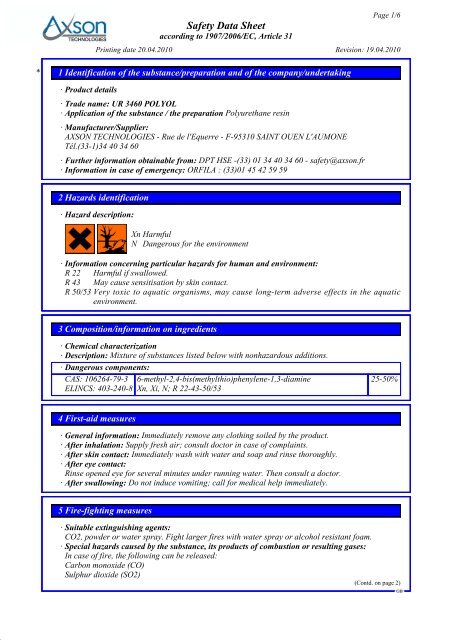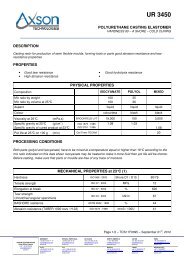Safety data sheet - Axson
Safety data sheet - Axson
Safety data sheet - Axson
Create successful ePaper yourself
Turn your PDF publications into a flip-book with our unique Google optimized e-Paper software.
DR<br />
<strong>Safety</strong> Data Sheet<br />
according to 1907/2006/EC, Article 31<br />
Page 1/6<br />
Printing date 20.04.2010 Revision: 19.04.2010<br />
* 1 Identification of the substance/preparation and of the company/undertaking<br />
· Product details<br />
· Trade name: UR 3460 POLYOL<br />
· Application of the substance / the preparation Polyurethane resin<br />
· Manufacturer/Supplier:<br />
AXSON TECHNOLOGIES - Rue de l'Equerre - F-95310 SAINT OUEN L'AUMONE<br />
Tél.(33-1)34 40 34 60<br />
· Further information obtainable from: DPT HSE -(33) 01 34 40 34 60 - safety@axson.fr<br />
· Information in case of emergency: ORFILA : (33)01 45 42 59 59<br />
2 Hazards identification<br />
· Hazard description:<br />
Xn Harmful<br />
N Dangerous for the environment<br />
· Information concerning particular hazards for human and environment:<br />
R 22 Harmful if swallowed.<br />
R 43 May cause sensitisation by skin contact.<br />
R 50/53 Very toxic to aquatic organisms, may cause long-term adverse effects in the aquatic<br />
environment.<br />
3 Composition/information on ingredients<br />
· Chemical characterization<br />
· Description: Mixture of substances listed below with nonhazardous additions.<br />
· Dangerous components:<br />
CAS: 106264-79-3<br />
ELINCS: 403-240-8<br />
4 First-aid measures<br />
6-methyl-2,4-bis(methylthio)phenylene-1,3-diamine<br />
Xn, Xi, N; R 22-43-50/53<br />
· General information: Immediately remove any clothing soiled by the product.<br />
· After inhalation: Supply fresh air; consult doctor in case of complaints.<br />
· After skin contact: Immediately wash with water and soap and rinse thoroughly.<br />
· After eye contact:<br />
Rinse opened eye for several minutes under running water. Then consult a doctor.<br />
· After swallowing: Do not induce vomiting; call for medical help immediately.<br />
5 Fire-fighting measures<br />
25-50%<br />
· Suitable extinguishing agents:<br />
CO2, powder or water spray. Fight larger fires with water spray or alcohol resistant foam.<br />
· Special hazards caused by the substance, its products of combustion or resulting gases:<br />
In case of fire, the following can be released:<br />
Carbon monoxide (CO)<br />
Sulphur dioxide (SO2)<br />
(Contd. on page 2)<br />
GB
DR<br />
<strong>Safety</strong> Data Sheet<br />
according to 1907/2006/EC, Article 31<br />
Page 2/6<br />
Printing date 20.04.2010 Revision: 19.04.2010<br />
Trade name: UR 3460 POLYOL<br />
(Contd. of page 1)<br />
Nitrogen oxides (NOx)<br />
· Protective equipment: Wear self-contained respiratory protective device.<br />
· Additional information<br />
Dispose of fire debris and contaminated fire fighting water in accordance with official regulations.<br />
6 Accidental release measures<br />
· Person-related safety precautions: Wear protective equipment. Keep unprotected persons away.<br />
· Measures for environmental protection:<br />
Do not allow product to reach sewage system or any water course.<br />
· Measures for cleaning/collecting:<br />
Absorb with liquid-binding material (sand, diatomite, acid binders, universal binders, sawdust).<br />
Dispose contaminated material as waste according to item 13.<br />
7 Handling and storage<br />
· Handling:<br />
· Information for safe handling:<br />
Inform personnel of risks associated with the product, the precautions to be taken and procedures<br />
to follow where an accident occurs.<br />
· Information about fire - and explosion protection: Protect from heat.<br />
· Storage:<br />
· Requirements to be met by storerooms and receptacles:<br />
Use only receptacles specifically permitted for this substance/product.<br />
· Information about storage in one common storage facility: Store away from foodstuffs.<br />
· Further information about storage conditions:<br />
Keep receptacle tightly sealed.<br />
Protect from humidity and water.<br />
This product is hygroscopic.<br />
8 Exposure controls/personal protection<br />
· Additional information about design of technical facilities: No further <strong>data</strong>; see item 7.<br />
· Ingredients with limit values that require monitoring at the workplace:<br />
The product does not contain any relevant quantities of materials with critical values that have to<br />
be monitored at the workplace.<br />
· Personal protective equipment:<br />
· General protective and hygienic measures:<br />
The usual precautionary measures are to be adhered to when handling chemicals.<br />
Immediately remove all soiled and contaminated clothing<br />
Wash hands before breaks and at the end of work.<br />
· Respiratory protection: Not necessary if room is well-ventilated.<br />
· Protection of hands:<br />
Protective gloves<br />
(Contd. on page 3)<br />
GB
DR<br />
<strong>Safety</strong> Data Sheet<br />
according to 1907/2006/EC, Article 31<br />
Page 3/6<br />
Printing date 20.04.2010 Revision: 19.04.2010<br />
Trade name: UR 3460 POLYOL<br />
(Contd. of page 2)<br />
· Material of gloves<br />
PVC gloves<br />
The selection of the suitable gloves does not only depend on the material, but also on further marks<br />
of quality and varies from manufacturer to manufacturer. As the product is a preparation of<br />
several substances, the resistance of the glove material can not be calculated in advance and has<br />
therefore to be checked prior to the application.<br />
· Penetration time of glove material<br />
The exact break trough time has to be found out by the manufacturer of the protective gloves and<br />
has to be observed.<br />
· Eye protection:<br />
<strong>Safety</strong> glasses<br />
Tightly sealed goggles<br />
· Body protection: Protective work clothing<br />
9 Physical and chemical properties<br />
· General Information<br />
Form: Fluid<br />
Colour: Black<br />
Odour: Characteristic<br />
· Change in condition<br />
Melting point/Melting range: NA°C<br />
· Flash point: > 110°C<br />
· Self-igniting: Product is not selfigniting.<br />
· Danger of explosion: Product does not present an explosion hazard.<br />
· Density at 20°C: 1.03 g/cm³ (ISO 1675:1985)<br />
· Solubility in / Miscibility with<br />
water: Not miscible or difficult to mix.<br />
· organic solvents: Soluble in many organic solvents.<br />
· pH-value at 20°C: NA<br />
10 Stability and reactivity<br />
· Thermal decomposition / conditions to be avoided:<br />
No decomposition if used according to specifications.<br />
· Dangerous reactions<br />
Reacts with oxidizing agents.<br />
Reacts with acids.<br />
· Dangerous decomposition products:<br />
Sulphur dioxide<br />
Carbon monoxide and carbon dioxide<br />
Nitrogen oxides (NOx)<br />
GB<br />
(Contd. on page 4)
DR<br />
<strong>Safety</strong> Data Sheet<br />
according to 1907/2006/EC, Article 31<br />
Page 4/6<br />
Printing date 20.04.2010 Revision: 19.04.2010<br />
Trade name: UR 3460 POLYOL<br />
11 Toxicological information<br />
· Acute toxicity:<br />
· LD/LC50 values relevant for classification:<br />
106264-79-3 6-methyl-2,4-bis(methylthio)phenylene-1,3-diamine<br />
Oral LD50 1515 mg/kg (rat)<br />
Dermal LD50 >2000 mg/kg (rabbit)<br />
· Primary irritant effect:<br />
· on the skin: No irritant effect.<br />
· on the eye: No irritating effect.<br />
· Sensitisation May cause sensitisation by skin contact.<br />
12 Ecological information<br />
· Information about elimination (persistence and degradability):<br />
· Other information: The product is difficultly biodegradable.<br />
· Ecotoxical effects:<br />
· Acquatic toxicity:<br />
106264-79-3 6-methyl-2,4-bis(methylthio)phenylene-1,3-diamine<br />
LC 50 (96h) 16.9 mg / l (fish)<br />
13 Disposal considerations<br />
(Contd. of page 3)<br />
· Product:<br />
· Recommendation<br />
Dispose of the product by burning in a suitable incinerator or bury in an approved landfield<br />
following all applicable local and/or national regulations.<br />
· European waste catalogue<br />
20 01 27 paint, inks, adhesives and resins containing dangerous substances<br />
· Uncleaned packaging:<br />
· Recommendation:<br />
Empty containers may not be disposed of unless any remaining material adhering to the internal<br />
walls has been removed.<br />
Disposal must be made according to official regulations.<br />
* 14 Transport information<br />
· Land transport ADR/RID (cross-border)<br />
· ADR/RID class: 9 Miscellaneous dangerous substances and articles.<br />
· Danger code (Kemler): 90<br />
· UN-Number: 3082<br />
· Packaging group: III<br />
(Contd. on page 5)<br />
GB
DR<br />
<strong>Safety</strong> Data Sheet<br />
according to 1907/2006/EC, Article 31<br />
Page 5/6<br />
Printing date 20.04.2010 Revision: 19.04.2010<br />
Trade name: UR 3460 POLYOL<br />
(Contd. of page 4)<br />
· Hazard label 9<br />
· Special marking: Symbol (fish and tree)<br />
· Description of goods: 3082 ENVIRONMENTALLY HAZARDOUS SUBSTANCE, LIQUID, N.O.S.<br />
(6-methyl-2,4-bis(methylthio)phenylene-1,3-diamine)<br />
· Maritime transport IMDG:<br />
· IMDG Class: 9<br />
· UN Number: 3082<br />
· Label 9<br />
· Packaging group: III<br />
· Marine pollutant: Symbol (fish and tree)<br />
· Proper shipping name: ENVIRONMENTALLY HAZARDOUS SUBSTANCE, LIQUID, N.O.S. (6methyl-2,4-bis(methylthio)phenylene-1,3-diamine)<br />
· Air transport ICAO-TI and IATA-DGR:<br />
· ICAO/IATA Class: 9<br />
· UN/ID Number: 3082<br />
· Label 9<br />
· Special marking: Symbol (fish and tree)<br />
· Packaging group: III<br />
· Proper shipping name: ENVIRONMENTALLY HAZARDOUS SUBSTANCE, LIQUID, N.O.S. (6methyl-2,4-bis(methylthio)phenylene-1,3-diamine)<br />
15 Regulatory information<br />
· Labelling according to EU guidelines:<br />
The product has been marked in accordance with EU Directives / respective national laws.<br />
· Code letter and hazard designation of product:<br />
Xn Harmful<br />
N Dangerous for the environment<br />
· Hazard-determining components of labelling:<br />
6-methyl-2,4-bis(methylthio)phenylene-1,3-diamine<br />
· Risk phrases:<br />
22 Harmful if swallowed.<br />
43 May cause sensitisation by skin contact.<br />
50/53 Very toxic to aquatic organisms, may cause long-term adverse effects in the aquatic<br />
environment.<br />
· <strong>Safety</strong> phrases:<br />
23 Do not breathe gas/fumes/vapour/spray.<br />
24 Avoid contact with skin.<br />
37 Wear suitable gloves.<br />
57 Use appropriate container to avoid environmental contamination.<br />
(Contd. on page 6)<br />
GB
DR<br />
<strong>Safety</strong> Data Sheet<br />
according to 1907/2006/EC, Article 31<br />
Page 6/6<br />
Printing date 20.04.2010 Revision: 19.04.2010<br />
Trade name: UR 3460 POLYOL<br />
60 This material and its container must be disposed of as hazardous waste.<br />
· National regulations:<br />
· Waterhazard class: Water hazard class 2 (Self-assessment): hazardous for water.<br />
(Contd. of page 5)<br />
16 Other information<br />
This information is based on our present knowledge. However, this shall not constitute a guarantee<br />
for any specific product features and shall not establish a legally valid contractual relationship.<br />
· Relevant R-phrases<br />
22 Harmful if swallowed.<br />
43 May cause sensitisation by skin contact.<br />
50/53 Very toxic to aquatic organisms, may cause long-term adverse effects in the aquatic<br />
environment.<br />
GB



